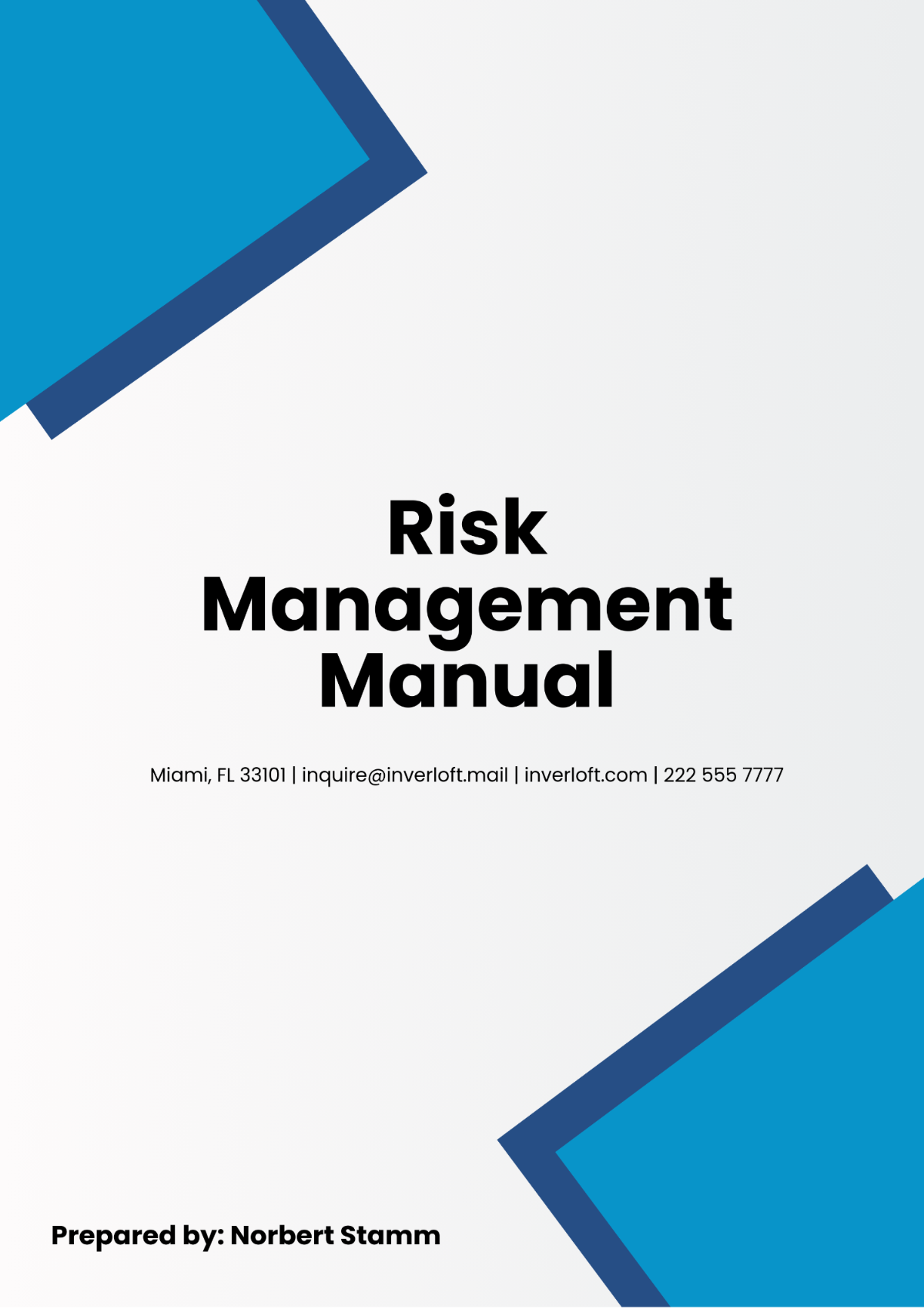Free Risk Management Manual

Prepared by: [Your Name]
I. Introduction
Effective risk management is vital for any organization's success and sustainability. This Risk Management Manual offers a framework for identifying, assessing, and mitigating risks at [Your Company Name], detailing processes, responsibilities, and strategies for proactive and systematic management. Following these guidelines helps safeguard assets, reputation, and operations.
II. Risk Management Framework
A. Objectives
The primary objectives of this Risk Management Manual are to:
Identify potential risks that could affect [Your Company Name].
Assess the likelihood and impact of these risks.
Develop and implement strategies to mitigate identified risks.
Monitor and review risk management practices regularly.
B. Risk Management Process
The risk management process at [Your Company Name] involves the following steps:
Risk Identification:
Tools and Techniques: Use tools such as SWOT analysis, PESTLE analysis, and risk workshops.
Sources of Risks: Internal and external sources, including market changes, regulatory shifts, and operational issues.
Risk Assessment:
Risk Analysis: Qualitative and quantitative analysis methods.
Risk Evaluation: Determine the significance of risks based on their likelihood and impact.
Risk Mitigation:
Risk Control Measures: Strategies such as avoidance, reduction, sharing, and acceptance.
Action Plans: Develop detailed action plans for each identified risk.
Risk Monitoring and Review:
Monitoring: Regular review of risk controls and procedures.
Review: Periodic assessment of the risk management framework and its effectiveness.
III. Roles and Responsibilities
A. Risk Management Committee
The Risk Management Committee is responsible for overseeing the risk management activities at [Your Company Name]. The committee’s responsibilities include:
Developing and updating risk management policies.
Ensuring compliance with risk management procedures.
Reviewing risk reports and making strategic decisions.
B. Risk Managers
Risk Managers are designated individuals responsible for implementing risk management practices. Their duties include:
Conducting risk assessments.
Developing risk mitigation plans.
Reporting on risk management activities.
C. Employees
All employees are responsible for adhering to risk management procedures and reporting any identified risks to their supervisors or the Risk Management Committee.
IV. Risk Identification and Assessment
A. Risk Categories
Risk Category | Description |
|---|---|
Strategic Risks | Risks related to strategic decisions and direction. |
Operational Risks | Risks associated with day-to-day operations. |
Financial Risks | Risks impacting the financial health of the company. |
Compliance Risks | Risks arising from non-compliance with regulations. |
Reputational Risks | Risks that may damage the company’s reputation. |
B. Risk Assessment Criteria
The assessment of risks is based on the following criteria:
Likelihood: The probability of the risk occurring.
Impact: The potential effect of the risk on the organization.
Exposure: The extent to which the organization is vulnerable to the risk.
C. Risk Assessment Matrix
Likelihood | Impact | Low | Medium | High |
|---|---|---|---|---|
High | Low | Medium | High | Critical |
Medium | Medium | Medium | High | High |
Low | High | High | High | Critical |
V. Risk Mitigation Strategies
A. Risk Avoidance
Strategies to avoid risks may include changing business processes or reframing business strategies to eliminate risk exposure.
B. Risk Reduction
Measures to reduce the likelihood or impact of risks. This includes implementing control measures, improving procedures, and investing in technology.
C. Risk Sharing
Sharing risk through partnerships, outsourcing, or insurance. This approach distributes the risk burden among multiple parties.
D. Risk Acceptance
Accepting the risk when the cost of mitigation is higher than the risk itself. This strategy involves closely monitoring the risk and being prepared to respond if it materializes.
VI. Monitoring and Review
A. Monitoring Procedures
Regular monitoring involves:
Tracking risk indicators and control measures.
Reviewing risk management reports and performance.
Conducting risk audits and assessments.
B. Review Schedule
The risk management framework should be reviewed annually or as significant changes occur within the organization. This includes:
Updating risk assessment procedures.
Revising risk mitigation strategies.
Ensuring continued compliance with regulations and standards.
C. Reporting
Regular reports on risk management activities should be prepared for the Risk Management Committee. These reports should include:
Summary of identified risks.
Status of risk mitigation actions.
Recommendations for improvements.
Contact Information
For further information or queries regarding this Risk Management Manual, please contact [Your Company Name] at:
Email: [Your Company Email]
Phone: [Your Company Number]
Website: [Your Company Website]
- 100% Customizable, free editor
- Access 1 Million+ Templates, photo’s & graphics
- Download or share as a template
- Click and replace photos, graphics, text, backgrounds
- Resize, crop, AI write & more
- Access advanced editor
Discover peace of mind with our Risk Management Manual Template, exclusively crafted by Template.net. This comprehensive resource is not just editable, but fully customizable to suit your unique needs. Seamlessly edit in our Ai Editor Tool, ensuring precision and efficiency in your risk management endeavors. Safeguard your business effectively today.





























